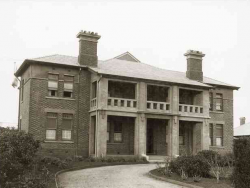Enfield Hospital
| Enfield Hospital | |
|---|---|
 | |
| Opened | 1922 |
| Closed | 1982 |
| Current Status | Demolished |
| Building Style | Cottage Plan |
| Location | Enfield, SA |
| Alternate Names |
|
History[edit]
The Enfield Receiving House was opened by the government in 1922 at Enfield. It was used for the observation and temporary treatment of patients who were not certified and sent to the mental hospital. It also admitted voluntary psychiatric patients. Children with intellectual disabilities, including State-children, were placed at the Receiving House, often in wards with adult patients. In 1963 the Enfield Receiving House was renamed the Enfield Hospital.
The establishment of a Receiving House as a place where potential patients could go for observation and temporary treatment without being certified and sent to the mental hospital was provided for in the Mental Defectives Act 1913. However, the Enfield Receiving House, which was opened by the government on 22 June 1922, was the first such institution in South Australia.
The term 'mental defective' replaced 'lunatic' in the new Act and referred to both people suffering from mental illness and those with intellectual disabilities.
The Receiving House was located on a 20 acre block at Enfield and opened with accommodation for between 45 and 50 patients. The first patients included 23 men and 20 women. By 1929 the Receiving House was treating 336 patients with a daily average of 37. During the year 159 patients were discharged and 128 patients were transferred to Parkside Mental Hospital.
With the passing of the Mental Defectives Act 1935 the Minister was given the power to send any person, incarcerated in any government 'prison, gaol, reformatory, industrial school or other place of confinement… that appeared to be mentally defective' to the 'hospital for criminal mental defectives'. This meant that State-children with intellectual disabilities who were removed from government institutions were required to be detained in a special section of the Enfield Receiving House where they were confined with adult criminals. By the 1950s concerns were being raised by the Children's Welfare and Public Relief Board that State-children of 'tender years' were being classified as 'criminal mental defectives' and being sent to institutions like Enfield Receiving House.
By 1945 the Enfield Receiving House, the Northfield Mental Hospital and the Parkside Mental Hospital were the only State-run facilities that accommodated children with intellectual disabilities. In 1953 an amendment to the Act extended the examination time for patients at the Receiving House from 7 days to 30 days.
In 1961 a report into State-run mental health services criticised the lumping together of the intellectually disabled with people suffering from mental illness, and the fact that young people continued to be housed with adult inmates at Parkside Mental Hospital and at the Enfield Receiving House. The report included disturbing statistics on the make-up of the population of these institutions and the Northfield Mental Hospital. Of a total population of 2500 patients, more than 600 were intellectually disabled and, of these, 142 were aged under 12.
The Enfield Hospital was the new name given to the Enfield Receiving House in 1963. It continued to operate as a Receiving Home for people with mental health problems and people with intellectual disabilities, including children. State-children with intellectual disabilities continued to be sent to Enfield Hospital. On 1st July, 1979, Enfield Hospital was incorporated with Hillcrest Hospital. Both Hospitals came under the control of a single board of management. In 1981 Enfield Hospital was providing specific purpose rehabilitation programs. By 1982 all patients had been transferred to Hillcrest Hospital.

